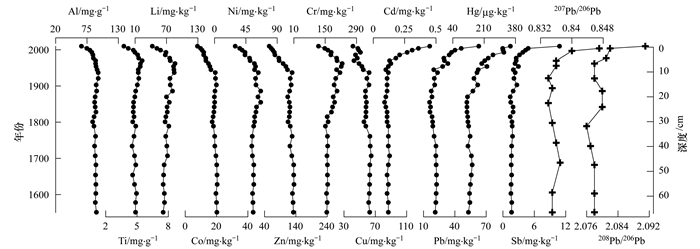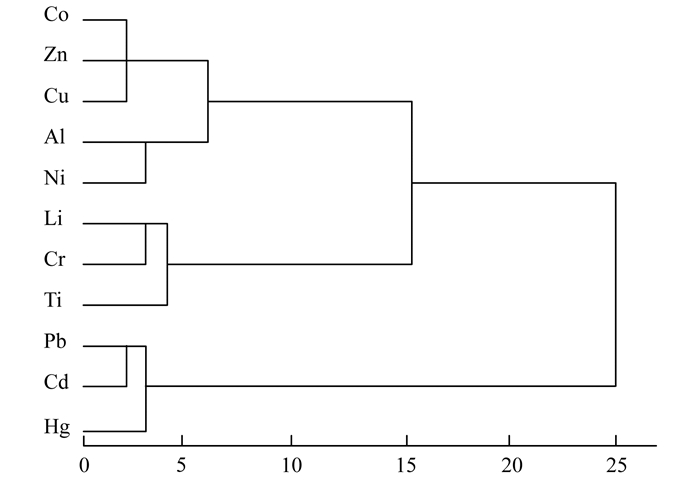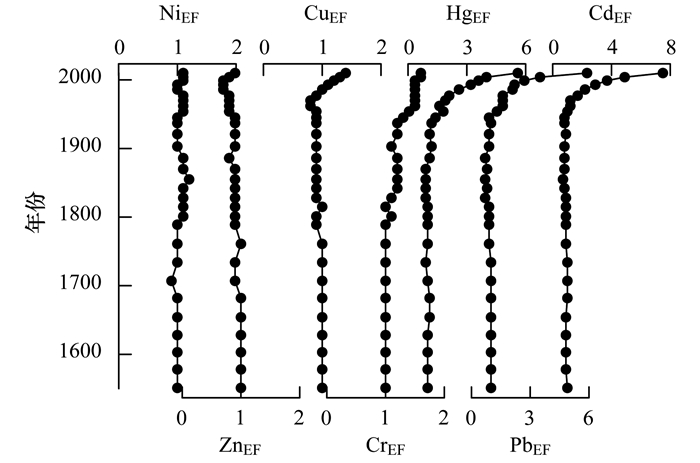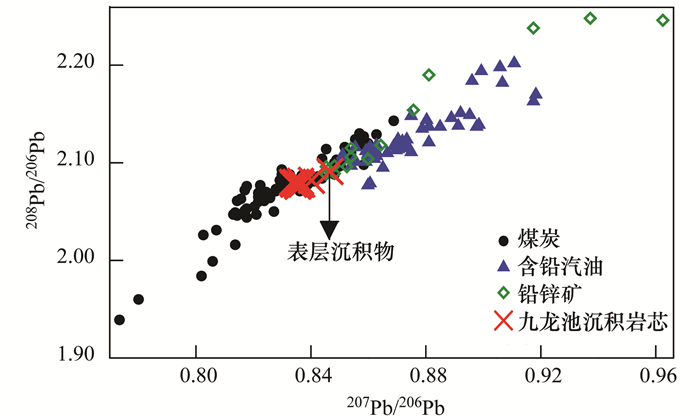2. 中国科学院南京地理与湖泊研究所湖泊与环境国家重点实验室, 南京 210008
2. State Key Laboratory of Lake Science and Environment, Nanjing Institute of Geography and Limnology, Chinese Academy of Sciences, Nanjing 210008, China
大气污染是全球备受关注的环境问题, 重金属是大气中典型的污染物. 19世纪中期以来, 有色金属开采与冶炼等工业活动、以及煤炭与石油等化石燃料的大量使用, 导致了欧美等地区大气重金属污染日趋严重[1].人为活动释放到大气中的重金属不仅对污染源区的生态环境与人类健康造成了极大地影响, 通过大气输移与持续沉降, 对偏远地区土壤与水体等环境也带了一定的负面影响[2, 3].
近年来, 随着我国与印度等国家经济的快速发展, 全球大气重金属释放与污染的热区由欧美地区转移到了亚洲[4, 5], 我国Cd、Hg和Pb等大气释放量已位居世界前列[4, 6].我国系统的大气污染监测与研究主要开始于20世纪90年代, 在重金属等典型污染物的污染现状、环境与健康危害方面取得了一系列成果[7], 但对大气重金属污染历史过程的研究还不够深入.高山地区受到人类活动直接影响较弱, 对重金属等大气污染响应敏感, 其广泛分布的湖泊与泥炭沉积为开展区域大气重金属污染历史变化研究提供了良好的载体[8, 9].目前, 我国对大气重金属污染历史过程的研究多集中于青藏高原、西南及西北等高山湖泊较为集中的地区[8, 10, 11], 而对东部地区大气重金属污染的历史过程及其对远离人类活动直接影响地区的地表环境影响的认识还存在一定不足.
贵州是我国重要的有色金属产地, 重金属污染较为突出[12].目前关于大气与土壤等重金属污染的研究多集中于有色金属矿区及周边地区[12~14], 对人类活动直接影响相对较弱的偏远山区大气重金属污染现状及其历史变化过程的研究较为薄弱.本文通过对贵州北部梵净山顶湖泊沉积物中金属元素含量、Pb同位素组成的分析, 结合210Pb年代结果, 研究了大气重金属污染变化的历史过程与累积特征, 并对污染来源进行了探讨, 以期为区域大气重金属污染防治、全面评估大气重金属污染对偏远地区环境质量的影响提供参考.
1 材料与方法 1.1 研究区域概况贵州是我国矿产资源大省, 有汞矿、铅锌矿等有色金属矿山240余座[15]; 贵州北部的万山汞矿是世界第三大汞矿, 也是我国最大的汞矿, 具有600余年的开采历史, 累计向大气释放汞约745 t[16].贵州省也是我国重要的煤炭产区和消费区, 产量和消费量位居全国第五位.与贵州省相邻的湖南、重庆矿产资源也较丰富, 其中湖南省Pb产量占全国16.9%[17].长期的矿产资源开采与有色金属冶炼对矿区及周边地区大气、土壤等生态环境质量与人体健康产生了较重的影响[12, 13].
梵净山位于贵州省铜仁市江口、印江、松桃三县交界处, 是武陵山山脉的主峰, 最高峰海拔2 494 m.九龙池位于梵净山最高峰南南西约2 km, 具有连续的湖相沉积[18], 目前为一季节性天然的积水洼地, 海拔2 212 m.
1.2 样品采集2012年, 使用荷兰Eijkelkamp公司生产的Cobra TT型采样器, 在九龙池中心位置采集了长67 cm的沉积岩芯.岩芯带回实验室后剖开, 以1 cm为间隔进行分样, 样品放入聚乙烯密封袋中低温保存.
1.3 分析方法样品冷冻干燥后, 采用美国EG&G Ortec公司生产的高纯锗井型探测器(HPGe GWL-120-15)测定210Pbtot和226Ra活度, 计算获得210Pbex的活度, 用于沉积岩芯年代序列的建立.
称取研磨后的样品0.12 g置入聚四氟乙烯烧杯中, 顺序加入HCl-HNO3-HF-HClO4, 置于电热板(160~180℃)上加热约2.5 h, 然后220℃加热至冒尽白烟, 冷却后加入1 mL HNO3、0.5 mL HCl和超纯水加热溶解残渣, 冷却后转移并定容至50 mL, 采用美国Leeman Labs Profile电感耦合等离子体原子发射光谱仪(ICP-AES)测定Al、Ti和Zn的含量, 采用电感耦合等离子体质谱仪(ICP-MS, Agilent 7700)测定Cd、Co、Cr、Cu、Li、Ni和Pb的含量及Pb同位素(206Pb、207Pb和208Pb)组成.沉积物中Hg含量采用美国Leeman Labs HydraⅡC型全自动测汞仪测定.分析过程中采用标准参考物质GBW07358进行精度控制, 各元素含量实测值均在标准值范围内, 平行分析最大偏差均小于7%. Pb同位素组成采用标准样品(SRM981-NIST)进行校准与控制, 208Pb/206Pb及207Pb/206Pb的测试结果标准偏差均小于0.12%.
1.4 重金属污染评价方法湖泊沉积物中的重金属除了大气沉降之外, 部分还来自流域土壤母质, 流域侵蚀条件可影响沉积物质地变化, 进而影响到自然来源的重金属的含量及污染定量识别[8, 11].研究中通常采用Al、Fe、Ti、Co和Li等作为参比进行沉积物质地变化矫正, 采用富集系数(EF)方法进行重金属元素的自然与人为来源区分[8, 11, 19].富集系数及人为重金属沉积通量计算方法见文献[8]; 本文采用Co和Li作为参比元素, 采用岩芯底部样品中金属元素含量作为准自然背景值[9].
2 结果与分析 2.1 沉积岩芯年代沉积岩芯中210Pbex活度随深度增加呈指数降低(R2=0.87), 采用CIC模式建立了沉积岩芯0~18 cm(质量深度0~6.79 g·cm-1)所对应的年代, 平均沉积通量为0.05 g·(cm2·a)-1, 平均沉积速率为0.15 cm·a-1.沉积岩芯18~67 cm所对应的年代采用0~18 cm平均沉积通量外推, 岩芯底部年代约为1 550年(图 1).

|
图 1 九龙池沉积岩芯中金属元素含量及铅同位素比值变化 Fig. 1 Temporal variations in metal concentrations and Pb isotopic ratios in sediment core samples from Lake Jiulong |
沉积岩芯中金属元素含量统计结果如表 1所示, 各金属元素平均含量依次为Al>Ti>Cr>Zn>Li>Cu>Ni>Pb>Co>Cd>Hg, 其中Cd、Hg、Pb含量的变异系数较大.垂向上, 各金属元素呈不同的变化趋势(图 1), 根据聚类分析的结果, 可将11种金属元素分为两组(图 2).第一组金属元素包括Al、Co、Cr、Cu、Li、Ni、Ti和Zn, 第二组元素包括Cd、Hg和Pb.约1800年之前, 所有金属元素含量波动较小, 无明显的变化趋势(图 1).约1800~1940年, 第一组元素含量逐渐上升; 约1940年以来, Al、Co、Cu、Ni和Zn含量逐渐下降, Cr、Li和Ti含量自1970年以来逐渐下降(图 1).第二组金属元素含量在1800~1880年较为稳定; Hg含量自1880年以来逐渐升高; Pb和Cd含量自1950年以来逐渐升高(图 1).
|
|
表 1 九龙池沉积岩芯中金属元素含量统计结果 Table 1 Statistics for metal concentrations in sediment core samples from Lake Jiulong |

|
图 2 九龙池沉积岩芯金属元素聚类分类结果 Fig. 2 Hierarchical classification of metals in sediment core samples from Lake Jiulong |
沉积岩芯中207Pb/206Pb和208Pb/206Pb比值如图 1所示. 207Pb/206Pb比值为0.834~0.847, 20世纪50年代之前, 207Pb/206Pb比值略呈波动状态, 无明显的变化趋势; 近年来207Pb/206Pb比值逐渐升高. 208Pb/206Pb比值为2.076~2.091, 与207Pb/206Pb相比波动较大, 岩芯上部(约1980年以来)208Pb/206Pb比值明显升高.沉积岩芯中207Pb/206Pb及208Pb/206Pb比值与Pb含量变化趋势基本一致.
2.3 富集系数沉积岩芯中, Zn、Ni、Cu、Cr、Pb、Cd和Hg的富集系数分别为0.7~1.0、0.9~1.2、0.8~1.4、1.0~1.6、0.7~5.9、0.7~7.5和0.9~5.6(图 3), 平均值分别为0.9、1.0、1.0、1.2、1.4、1.5和1.6; Ni和Zn的富集系数接近于1, 近50年沉积物中Cr、Cu的富集系数略大约1. Hg、Pb和Cd的富集系数变化趋势与其他元素明显不同, 约1880年之前, Cd、Pb和Hg的富集系数接近于1;约1880年以来, Hg的富集系数逐渐增加, 约1950年以来, Pb和Cd的富集系数逐渐升高, 并在表层沉积物中达到最大值.富集系数结果表明, 沉积物中Cu、Cr、Ni和Zn以自然来源为主; Cd、Hg和Pb含量与其他金属元素呈显著负相关(P<0.01), 岩芯上部其富集系数逐渐增加指示了人为污染的影响.

|
图 3 九龙池沉积岩芯中金属元素富集系数(EF) Fig. 3 Variations in enrichment factors (EF) of metals in sediment core samples from Lake Jiulong |
根据沉积岩芯中Hg富集系数的变化(图 3), Hg污染开始于1880年前后, 近年来污染程度逐渐加重; 其污染历史过程与趋势与海南湖光岩湖泊沉积记录一致[20], 与欧美、中亚在内的全球绝大多数地区大气Hg污染初始时间基本吻合[10, 21].前人研究表明, 全球Hg人为排放显著增加开始于19世纪中期[4, 22], 近年来欧美等部分地区大气Hg污染程度有所降低[6, 23, 24]; 但九龙池沉积记录反映的大气Hg污染程度逐渐增加(图 3), 这一特征与亚洲绝大多数地区研究结果相似[21, 25~27].
1880年以来, 九龙池沉积物中Hg沉积通量持续增加(图 4), 20世纪末期以来, 人为Hg的沉积通量平均为119 μg·(m2·a)-1, 与海南湖光岩[20]、东南亚地区[90~110 μg·(m2·a)-1][28]湖泊沉积记录的大气Hg污染沉积通量相似, 与我国东部城郊地区[77~152 μg·(m2·a)-1][29]、四川西部贡嘎山地区[92.5 μg·(m2·a)-1][30]大气Hg沉降监测结果、以及全球大气Hg沉降模拟结果较为一致[31].然而, 梵净山等我国东部地区大气Hg沉降通量明显高于中亚冰芯[0.88 μg·(m2·a)-1][21]、青藏高原冰芯与积雪[0.7 μg·(m2·a)-1、0.7~7.9 μg·(m2·a)-1][25]和湖泊沉积[5~32 μg·(m2·a)-1、5.1~7.9 μg·(m2·a)-1][26, 27]记录, 也高于近年来北欧[平均7 μg·(m2·a)-1][32]和北美五大湖区[5~30 μg·(m2·a)-1][24]大气Hg沉降通量.

|
图 4 九龙池沉积岩芯中Hg、Pb和Cd的沉积通量历史变化 Fig. 4 Sedimentary flux of Hg, Pb and Cd in the sediment core samples from Lake Jiulong |
统计表明, 20世纪中期之前我国大气Hg人为排放量较低, 其中1949年仅为12.7 t[7], 而20世纪中期之前全球人为Hg大气年释放量在750 t以上[4].建国后我国大气Hg人为释放量呈快速增加趋势, 2012年达到了695 t·a-1[7], 占到全球人为Hg大气排放量的近1/3和亚洲地区人为汞排放的50%以上[4].九龙池沉积记录的大气Hg污染初始过程与欧美等地区基本一致; 20世纪中期以来, 九龙池沉积记录与我国人为Hg大气排放趋势、以及前人关于我国其他地区大气Hg污染逐渐增加的研究结果[20, 28]相似, 而与20世纪90年代以来欧洲大气Hg污染水平下降了50%以上的特点完全不同[6].因此, 梵净山地区的大气汞污染在20世纪中期之前应受全球源的影响较大, 20世纪中期以来区域源的贡献日益显著.
3.2 镉、铅污染历史过程与来源有色金属冶炼、含铅汽油以及煤炭燃烧释放被认为是大气中人为Pb的主要来源[9, 33], 不同来源Pb的同位素组成存在明显的差异, 作为一种“指纹”特征, Pb同位素在污染与源示踪研究中得到广泛应用[34~36].根据富集系数和207Pb/206Pb比值(图 1和图 3), 梵净山地区Cd与Pb污染开始于20世纪中期, 20世纪80年代以来呈逐渐加重态势, 这与我国其他地区大气Cd和Pb污染沉积记录[8]、以及人为大气释放趋势[7]吻合.近年来, 九龙池沉积物中人为Pb沉积通量[16.2 mg·(m2·a)-1]与广州[17 mg·(m2·a)-1][37]、青海湖[12.2 mg·(m2·a)-1][19]以及贡嘎山[16.3 mg·(m2·a)-1][8]研究结果相当, 但略低于鼎湖山[42.8 mg·(m2·a)-1][37]、以及云南中部[32~53 mg·(m2·a)-1][11].梵净山地区大气Cd沉积通量[0.14 mg·(m2·a)-1]明显低于广州[1 mg·(m2·a)-1]、鼎湖山[0.57 mg·(m2·a)-1][37]、贡嘎山[0.77 mg·(m2·a)-1][8]; 但梵净山地区大气Pb与Cd沉积通量与华北地区偏远乡村[分别为14 mg·(m2·a)-1、0.29 mg·(m2·a)-1]相当[38].
工业革命以来, 欧美等地区大气Pb污染逐渐增强; 20世纪20~30年代, 随着含铅汽油的使用大气Pb污染程度显著增加; 而20世纪70~80年代以来, 随着大气清洁法案以及汽油无铅化等减排措施的实施, 欧洲Cd和Pb的释放量分别下降了60%和85%以上, 大气污染程度逐渐降低[6, 9, 23]. 1950年之前, 九龙池沉积物中并没有明显的Cd、Pb污染信号, 并且也缺少诸如欧洲等地区广泛分布的工业革命前大气Pb污染的信号[9]. 20世纪50年代中期以来, 九龙池岩芯中人为Pb和Cd累积量分别为98.7 mg·m-2和0.65 mg·m-2 (图 4).欧洲瑞典地区近3000年来人为Pb的累积沉降通量为1000~10 000 mg·m-2, 其中工业革命以来的贡献量占到50%左右[9]; 近千年来, 欧洲南部比利牛斯山脉湖泊沉积记录的人为Pb和Cd累积通量分别为1 000 mg·m-2和10 mg·m-2[39].
以上对比研究表明, Cd与Pb污染水平在不同地区间存在较大差异, 并没有明显的区域性变化规律; 我国不同地区间大气Cd和Pb污染趋势相似, 但与欧美地区存在明显不同; 大气中人为Pb和Cd沉降对我国地表环境的影响远小于欧美等工业历史较为悠久的地区.与Hg不同, 人为活动释放到大气中的Pb和Cd等重金属主要以颗粒态形式存在, 对大气环境的影响程度随污染源距离增加而明显降低[9, 14].结合地区间大气Pb和Cd污染历史过程的对比结果及其大气输移特性等, 笔者认为梵净山地区大气Pb和Cd污染主要响应于区域污染排放, 二者具有相同的污染历史过程, 因此污染来源可能相同.
为了进一步探讨梵净山地区大气Pb的来源, 对我国煤炭、含铅汽油、铅锌矿等主要潜在污染源与九龙池沉积物中Pb同位素比值进行了对比(图 5).九龙池沉积物中Pb同位素组成介于煤炭、含铅汽油以及有色金属之间, 表层沉积物中Pb同位素组成更趋于有色金属和含铅汽油.含铅汽油是大气Pb的重要来源之一, 包括我国在内的全球绝大多数国家在20世纪末已禁止含铅汽油的使用.天津、上海等城市监测结果表明, 随着含铅汽油的禁用, 大气颗粒物中207Pb/206Pb比值明显降低[35, 40]; 但与此不同, 九龙池沉积岩芯顶部207Pb/206Pb为整个岩芯的最高值(图 1), 因此, 含铅汽油释放并非是近年来沉积物中Pb污染程度逐渐增加的主要贡献源.根据潜在污染源Pb同位素组成以及沉积岩芯Pb同位素变化趋势, 笔者认为梵净山地区近年来大气Pb污染程度增加受到有色金属冶炼释放的影响更为显著; 这与南岭地区Cd和Pb污染来源[2]、以及西南地区大气Pb污染主要来源于铅锌等有色金属的冶炼的结论一致[11].除此之外, 梵净山地区大气Pb和Cd污染可能还受到燃煤释放的影响, 有待进一步研究.

|
图 5 我国煤炭、汽油、铅锌矿[35]及梵净山九龙池中的铅同位素散点图 Fig. 5 Scatter plot of lead isotopes in Chinese coal, leaded gasoline, lead-zinc ore, and sediment from Lake Jiulong |
梵净山九龙池沉积物中金属元素含量依次为Al>Ti>Cr>Zn>Li>Cu>Ni>Pb>Co>Cd>Hg.富集系数以及Pb同位素组成较好地反映了大气重金属污染元素及其历史变化, 其中Hg、Pb和Cd为典型污染物, Hg污染开始于1880年左右, Pb和Cd污染开始于20世纪50年代, 并呈逐渐增加趋势. Hg污染受到全球源及区域源的共同影响, 近年来区域源的影响更为明显; 有色金属冶炼释放是大气Pb和Cd污染的重要来源.沉积物中人为Hg、Pb和Cd的累积量分别为948 μg·m-2、98.7 mg·m-2和0.65 mg·m-2, 与欧美地区相比, 大气重金属污染对研究区地表环境的影响处于较低水平.
致谢: 感谢朱育新副研究员、夏威岚高级工程师、蔡艳杰工程师、陈嵘博士、孙伟伟博士、李凯博士在实验分析和野外采样中给予的帮助.| [1] | Hansson S V, Claustres A, Probst A, et al. Atmospheric and terrigenous metal accumulation over 3000 years in a French mountain catchment:Local vs distal influences[J]. Anthropocene, 2017, 19: 45-54. DOI:10.1016/j.ancene.2017.09.002 |
| [2] | Lee C S L, Li X D, Zhang G, et al. Biomonitoring of trace metals in the atmosphere using moss (Hypnum plumaeforme) in the Nanling Mountains and the Pearl River Delta, Southern China[J]. Atmospheric Environment, 2005, 39(3): 397-407. DOI:10.1016/j.atmosenv.2004.09.067 |
| [3] | Dietz R, Outridge P M, Hobson K A. Anthropogenic contributions to mercury levels in present-day arctic animals-A review[J]. Science of the Total Environment, 2009, 407(24): 6120-6131. DOI:10.1016/j.scitotenv.2009.08.036 |
| [4] | Streets D G, Devane M K, Lu Z F, et al. All-time releases of mercury to the atmosphere from human activities[J]. Environmental Science & Technology, 2011, 45(24): 10485-10491. |
| [5] | Corbitt E S, Jacob D J, Holmes C D, et al. Global source-receptor relationships for mercury deposition under present-day and 2050 emissions scenarios[J]. Environmental Science & Technology, 2011, 45(24): 10477-10484. |
| [6] | Pacyna J M, Pacyna E G, Aas W. Changes of emissions and atmospheric deposition of mercury, lead, and cadmium[J]. Atmospheric Environment, 2009, 43(1): 117-127. DOI:10.1016/j.atmosenv.2008.09.066 |
| [7] | Tian H Z, Zhu C Y, Gao J J, et al. Quantitative assessment of atmospheric emissions of toxic heavy metals from anthropogenic sources in China:historical trend, spatial distribution, uncertainties, and control policies[J]. Atmospheric Chemistry and Physics, 2015, 15(17): 10127-10147. DOI:10.5194/acp-15-10127-2015 |
| [8] | Bing H J, Wu Y H, Zhou J, et al. Historical trends of anthropogenic metals in Eastern Tibetan Plateau as reconstructed from alpine lake sediments over the last century[J]. Chemosphere, 2016, 148: 211-219. DOI:10.1016/j.chemosphere.2016.01.042 |
| [9] | Bindler R. Contaminated lead environments of man:reviewing the lead isotopic evidence in sediments, peat, and soils for the temporal and spatial patterns of atmospheric lead pollution in Sweden[J]. Environmental Geochemistry and Health, 2011, 33(4): 311-329. DOI:10.1007/s10653-011-9381-7 |
| [10] | Kang S C, Huang J, Wang F Y, et al. Atmospheric mercury depositional chronology reconstructed from lake sediments and ice core in the Himalayas and Tibetan Plateau[J]. Environmental Science & Technology, 2016, 50(6): 2859-2869. |
| [11] | Liu E F, Zhang E L, Li K, et al. Historical reconstruction of atmospheric lead pollution in central Yunnan province, southwest China:an analysis based on lacustrine sedimentary records[J]. Environmental Science and Pollution Research, 2013, 20(12): 8739-8750. DOI:10.1007/s11356-013-1861-0 |
| [12] | Feng X B, Qiu G L. Mercury pollution in Guizhou, Southwestern China-An overview[J]. Science of the Total Environment, 2008, 400(1-3): 227-237. DOI:10.1016/j.scitotenv.2008.05.040 |
| [13] |
孟忠常, 吴迪, 邓琴, 等. 贵州典型铅锌矿区土壤重金属污染特征与生态危害风险评价[J]. 贵州农业科学, 2012, 40(8): 218-221. Meng Z C, Wu D, Deng Q, et al. Characteristics of heavy metal pollutions in soils of typical lead-zinc mining areas in Guizhou Province and the ecological risk assessment[J]. Guizhou Agricultural Science, 2012, 40(8): 218-221. DOI:10.3969/j.issn.1001-3601.2012.08.063 |
| [14] | Xie F, Tan H, Yang B, et al. The study of atmospheric transport and deposition of cadmium emitted from primitive zinc production area[J]. Water, Air, & Soil Pollution, 2014, 225(11): 2162. |
| [15] |
朱学书, 尹努寻, 杨秀丽. 贵州矿产资源开发利用现状分析[J]. 贵州地质, 2012, 29(3): 220-224, 219. Zhu X S, Yin N X, Yang X L. Analysis on development and utilization condition of mineral resource in Guizhou[J]. Guizhou Geology, 2012, 29(3): 220-224, 219. DOI:10.3969/j.issn.1000-5943.2012.03.015 |
| [16] |
丁振华, 王文华, 瞿丽雅, 等. 贵州万山汞矿区汞的环境污染及对生态系统的影响[J]. 环境科学, 2004, 25(2): 111-114. Ding Z H, Wang W H, Qu L Y, et al. Mercury pollution and its ecosystem effects in Wanshan mercury miner area, Guizhou[J]. Environmental Science, 2004, 25(2): 111-114. DOI:10.3321/j.issn:0250-3301.2004.02.023 |
| [17] | Li Z G, Feng X B, Li G H, et al. Mercury and other metal and metalloid soil contamination near a Pb/Zn smelter in east Hunan province, China[J]. Applied Geochemistry, 2011, 26(2): 160-166. DOI:10.1016/j.apgeochem.2010.11.014 |
| [18] |
陈佩英, 周启勇, 林树基, 等. 贵州梵净山九龙池一万年来的植被和气候变化[J]. 贵州地质, 1992, 9(2): 167-177. Chen P Y, Zhou Q Y, Lin S J, et al. The changes of vegetation and climate of Jiulongchi section of Fanjingshan Mountain in Guizhou since 10000 years ago[J]. Guizhou Geology, 1992, 9(2): 167-177. |
| [19] | Jin Z D, Han Y M, Chen L. Past atmospheric Pb deposition in Lake Qinghai, Northeastern Tibetan Plateau[J]. Journal of Paleolimnology, 2010, 43(3): 551-563. DOI:10.1007/s10933-009-9351-6 |
| [20] | Zeng Y, Chen J G, Yang Y Q, et al. Huguangyan Maar Lake (SE China):A solid record of atmospheric mercury pollution history in a non-remote region[J]. Journal of Asian Earth Sciences, 2017, 147: 1-8. DOI:10.1016/j.jseaes.2017.07.009 |
| [21] | Eyrikh S, Eichler A, Tobler L, et al. A 320 year ice-core record of atmospheric Hg pollution in the Altai, Central Asia[J]. Environmental Science & Technology, 2017, 51(20): 11597-11606. |
| [22] | Amos H M, Sonke J E, Obrist D, et al. Observational and modeling constraints on global anthropogenic enrichment of mercury[J]. Environmental Science & Technology, 2015, 49(7): 4036-4047. |
| [23] | Cortizas A M, Varela E P, Bindler R, et al. Reconstructing historical Pb and Hg pollution in NW Spain using multiple cores from the Chao de Lamoso bog (Xistral Mountains)[J]. Geochimica et Cosmochimica Acta, 2012, 82(4): 68-78. |
| [24] | Kerfoot W C, Urban N R, McDonald C P, et al. Legacy mercury releases during copper mining near Lake Superior[J]. Journal of Great Lakes Research, 2016, 42(1): 50-61. DOI:10.1016/j.jglr.2015.10.007 |
| [25] | Zhang Q G, Hang J, Wang F Y, et al. Mercury distribution and deposition in glacier snow over western China[J]. Environmental Science & Technology, 2012, 46(10): 5404-5413. |
| [26] | Wang X P, Yang H H, Gong P, et al. One century sedimentary records of polycyclic aromatic hydrocarbons, mercury and trace elements in the Qinghai Lake, Tibetan Plateau[J]. Environmental Pollution, 2010, 158(10): 3065-3070. DOI:10.1016/j.envpol.2010.06.034 |
| [27] | Yang H D, Battarbee R W, Turner S D, et al. Historical reconstruction of mercury pollution across the Tibetan Plateau using lake sediments[J]. Environmental Science & Technology, 2010, 44(8): 2918-2924. |
| [28] | Engels S, Fong L S R Z, Chen Q, et al. Historical atmospheric pollution trends in Southeast Asia inferred from lake sediment records[J]. Environmental Pollution, 2018, 235: 907-917. DOI:10.1016/j.envpol.2018.01.007 |
| [29] | Fu X W, Feng X B, Sommar J, et al. A review of studies on atmospheric mercury in China[J]. Science of the Total Environment, 2012, 421-422: 73-81. DOI:10.1016/j.scitotenv.2011.09.089 |
| [30] | Fu X W, Feng X B, Zhu W Z, et al. Elevated atmospheric deposition and dynamics of mercury in a remote upland forest of Southwestern China[J]. Environmental Pollution, 2010, 158(6): 2324-2333. DOI:10.1016/j.envpol.2010.01.032 |
| [31] | Pacyna J M, Travnikov O, De Simone F, et al. Current and future levels of mercury atmospheric pollution on a global scale[J]. Atmospheric Chemistry and Physics, 2016, 16(19): 12495-12511. DOI:10.5194/acp-16-12495-2016 |
| [32] | Drevnick P E, Yang H D, Lamborg C H, et al. Net atmospheric mercury deposition to Svalbard:Estimates from lacustrine sediments[J]. Atmospheric Environment, 2012, 59: 509-513. DOI:10.1016/j.atmosenv.2012.05.048 |
| [33] | Duan J C, Tan J H. Atmospheric heavy metals and arsenic in China:Situation, sources and control policies[J]. Atmospheric Environment, 2013, 74: 93-101. DOI:10.1016/j.atmosenv.2013.03.031 |
| [34] | Chen J M, Tan M G, Li Y L, et al. A lead isotope record of shanghai atmospheric lead emissions in total suspended particles during the period of phasing out of leaded gasoline[J]. Atmospheric Environment, 2005, 39(7): 1245-1253. DOI:10.1016/j.atmosenv.2004.10.041 |
| [35] | Bi X Y, Li Z G, Wang S X, et al. Lead isotopic compositions of selected coals, Pb/Zn ores and fuels in China and the application for source tracing[J]. Environmental Science & Technology, 2017, 51(22): 13502-13508. |
| [36] |
张棕巍, 胡恭任, 于瑞莲, 等. 泉州市大气降尘中金属元素污染特征及来源解析[J]. 环境科学, 2016, 37(8): 2881-2888. Zhang Z W, Hu G R, Yu R L, et al. Characteristics and source apportionment of metals in the dustfall of Quanzhou City[J]. Environmental Science, 2016, 37(8): 2881-2888. |
| [37] | Ye L M, Huang M J, Zhong B Q, et al. Wet and dry deposition fluxes of heavy metals in Pearl River Delta Region (China):Characteristics, ecological risk assessment, and source apportionment[J]. Journal of Environmental Sciences, 2018, 70: 106-123. DOI:10.1016/j.jes.2017.11.019 |
| [38] | Pan Y P, Wang Y S. Atmospheric wet and dry deposition of trace elements at 10 sites in Northern China[J]. Atmospheric Chemistry and Physics, 2015, 15(2): 951-972. DOI:10.5194/acp-15-951-2015 |
| [39] | Bacardit M, Krachler M, Camarero L. Whole-catchment inventories of trace metals in soils and sediments in mountain lake catchments in the Central Pyrenees:Apportioning the anthropogenic and natural contributions[J]. Geochimica et Cosmochimica Acta, 2012, 82: 52-67. DOI:10.1016/j.gca.2010.10.030 |
| [40] | Wang W, Liu X D, Zhao L W, et al. Effectiveness of leaded petrol phase-out in Tianjin, China based on the aerosol lead concentration and isotope abundance ratio[J]. Science of the Total Environment, 2006, 364(1-3): 175-187. DOI:10.1016/j.scitotenv.2005.07.002 |
 2019, Vol. 40
2019, Vol. 40


